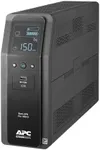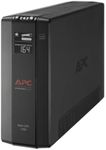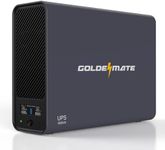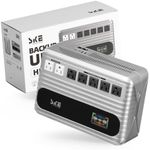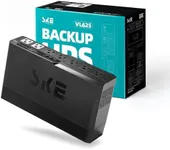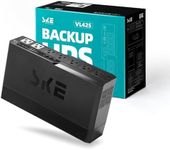Buying Guide for the Best Ups Backups
When choosing a UPS (Uninterruptible Power Supply) backup, it's important to understand that this device is designed to provide emergency power to your electronics in the event of a power outage. The right UPS can protect your equipment from data loss, hardware damage, and downtime. To make an informed decision, you need to consider several key specifications that will determine the suitability of a UPS for your needs.Power Capacity (VA/W)Power capacity, measured in Volt-Amps (VA) and Watts (W), indicates the maximum load a UPS can handle. This is crucial because it determines how many devices you can connect and how much power they can draw. To navigate this, calculate the total wattage of all devices you plan to connect. For home use, a UPS with a capacity of 600-1000 VA might suffice, while for office setups, you might need 1500 VA or more. Choose a UPS with a capacity that exceeds your total wattage by at least 20% to ensure reliable performance.
Battery RuntimeBattery runtime refers to how long the UPS can power your devices during an outage. This is important for ensuring you have enough time to save work and shut down equipment properly. Runtime can vary from a few minutes to several hours. For basic needs, a UPS with 5-10 minutes of runtime might be enough, but for critical systems, you may need 30 minutes or more. Consider your typical power outage duration and the importance of your devices to determine the right runtime for you.
Number of OutletsThe number of outlets on a UPS determines how many devices you can connect. This is important for ensuring all your essential equipment is protected. Outlets can be divided into battery-backed and surge-only. For a home office, 4-6 battery-backed outlets might be sufficient, while larger setups may require 8 or more. Count the devices you need to protect and ensure the UPS has enough outlets to accommodate them.
Form FactorForm factor refers to the physical size and shape of the UPS. This is important for ensuring it fits in your intended space. UPS units come in various forms, such as tower, rack-mounted, and compact. For home use, a compact or tower UPS might be ideal, while for server rooms, a rack-mounted unit could be more appropriate. Consider where you will place the UPS and choose a form factor that fits comfortably in that space.
Surge ProtectionSurge protection safeguards your devices from voltage spikes, which can cause damage. This is important for protecting sensitive electronics. Look for a UPS with a high joule rating, which indicates better protection. For basic protection, 200-400 joules might be enough, but for more sensitive equipment, look for 600 joules or higher. Assess the sensitivity of your devices and choose a UPS with adequate surge protection.
Automatic Voltage Regulation (AVR)Automatic Voltage Regulation (AVR) stabilizes the voltage supplied to your devices, preventing damage from voltage fluctuations. This is important for maintaining consistent power quality. AVR is particularly useful in areas with unstable power supply. If you experience frequent voltage fluctuations, choose a UPS with AVR to ensure your devices receive stable power.
Connectivity and MonitoringConnectivity and monitoring features allow you to manage and monitor your UPS remotely. This is important for ensuring your UPS is functioning correctly and for receiving alerts about power issues. Look for UPS units with USB or network connectivity and compatible software. For basic needs, simple USB connectivity might suffice, but for more advanced monitoring, network connectivity and comprehensive software are beneficial. Consider how much control and information you need about your UPS to choose the right connectivity options.



